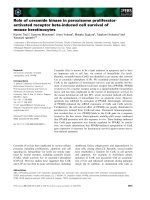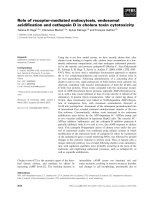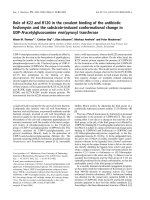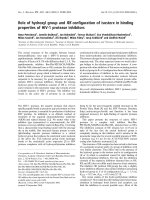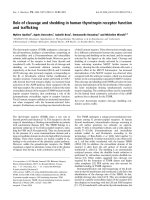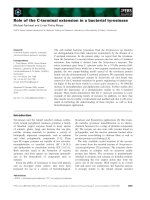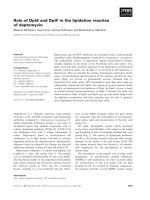Báo cáo khoa học: Role of gangliosides in the association of ErbB2 with lipid rafts in mammary epithelial HC11 cells docx
Bạn đang xem bản rút gọn của tài liệu. Xem và tải ngay bản đầy đủ của tài liệu tại đây (337.15 KB, 10 trang )
Role of gangliosides in the association of ErbB2 with lipid
rafts in mammary epithelial HC11 cells
Elena Sottocornola
1
, Roberta Misasi
2
, Vincenzo Mattei
2,3
, Laura Ciarlo
2
, Roberto Gradini
2,4
,
Tina Garofalo
2,3
, Bruno Berra
1
, Irma Colombo
1
and Maurizio Sorice
2,3
1 Institute of General Physiology and Biological Chemistry, University of Milan, Italy
2 Department of Experimental Medicine and Pathology, University of Rome ‘La Sapienza’, Italy
3 Laboratory of Experimental Medicine and Environmental Pathology, Rieti, Italy
4 INM Neuromed, Pozzilli, Italy
Gangliosides, ubiquitous components of eukaryotic
membranes, are not uniformly distributed within the
outer leaflet of the plasma membrane, but segregate,
together with cholesterol, glycosylphosphatidylinositol-
anchored proteins and signaling-transduction mole-
cules, into unique, more or less stable clusters or
microdomains called as ‘glycosphingolipid-enriched
microdomains’ (GEM), which contribute to membrane
structure, organization and, more importantly, func-
tion. Indeed, GEM are viewed as a dynamic and pref-
erential association of sphingolipids and cholesterol
into moving platforms, termed lipid rafts, which can
selectively incorporate or exclude proteins [1] and con-
tribute to lipid-mediated protein trafficking and signal
transduction [2].
The growth factor receptor tyrosine kinase ErbB2
is a 185 kDa transmembrane glycoprotein intensively
investigated because of its important role in normal
mammary gland development and in the deregulation
of growth displayed by cancer cells, including breast
and ovarian tumor cells [3,4]. A ligand which binds
directly and specifically to ErbB2 has not been identi-
fied to date, but it can be activated in trans by ligands
binding to epidermal growth factor receptor (EGFR),
such as epidermal growth factor (EGF) and transform-
ing growth factor a1 [3]. Indeed, in cells coexpressing
both ErbB2 and EGFR, EGF preferentially stimulates
the formation of ErbB2 ⁄ EGFR heterodimers in which
cross-phosphorylation occurs [5,6]. Data concerning
the structural and mechanistic aspects required for
Keywords
epidermal growth factor receptor; ErbB2;
GM3; HC11 cells; lipid rafts
Correspondence
M. Sorice, Department of Experimental
Medicine and Pathology, University of Rome
‘La Sapienza’, viale Regina Elena 324,
Rome 00161, Italy
Fax: +39 6 445 4820
Tel: +39 6 499 72675
E-mail:
(Received 24 December 2005, revised 15
February 2006, accepted 27 February 2006)
doi:10.1111/j.1742-4658.2006.05203.x
We analyzed the role of gangliosides in the association of the ErbB2 recep-
tor tyrosine-kinase (RTK) with lipid rafts in mammary epithelial HC11
cells. Scanning confocal microscopy experiments revealed a strict ErbB2–
GM3 colocalization in wild-type cells. In addition, analysis of membrane
fractions obtained using a linear sucrose gradient showed that ErbB2, epi-
dermal growth factor receptor (EGFR) and Shc-p66 (proteins correlated
with the ErbB2 signal transduction pathway) were preferentially enriched
in lipid rafts together with gangliosides. Blocking of endogenous
ganglioside synthesis by (+ ⁄ –)-threo-1-phenyl-2-decanoylamino-3-morpho-
lino-1-propanol hydrochloride ([D]-PDMP) induced a drastic cell-surface
redistribution of ErbB2, EGFR and Shc-p66, within the Triton-soluble
fractions, as revealed by linear sucrose-gradient analysis. This redistribution
was partially reverted when exogenous GM3 was added to ganglioside-
depleted HC11 cells. The results point out the key role of ganglioside GM3
in retaining ErbB2 and signal-transduction-correlated proteins in lipid
rafts.
Abbreviations
[D]-PDMP, (+ ⁄ –)-threo-1-phenyl-2-decanoylamino-3-morpholino-1-propanol hydrochloride; EGF, epidermal growth factor; EGFR, epidermal
growth factor receptor; FITC, fluorescein isothiocyanate; GEM, glycosphingolipid-enriched microdomains; HRP, horseradish peroxidase;
Rf, retardation factor; RTK, receptor tyrosine-kinase; TX-100, Triton X-100.
FEBS Journal 273 (2006) 1821–1830 ª 2006 The Authors Journal compilation ª 2006 FEBS 1821
EGF-dependent ‘trans activation’ of EGFR and ErbB2
in ErbB2 ⁄ EGFR heterodimers, as well as data con-
cerning the overall effects induced by changes in the
relative expression levels of EGFR and ErbB2, are
growing rapidly and several lines of evidence have
shown that ErbB2 is associated with lipid microdo-
mains [7–10]. By contrast, the role of cell-membrane
components, such as gangliosides, for determining the
plasma membrane distribution and relative densities of
receptors has not yet been investigated thoroughly.
Recently, we reported the first evidence that ganglio-
side depletion associates with increased levels of the
activated ErbB2 and EGFR, whereas increased gan-
glioside GM3 content correlates with the downregula-
tion of both receptors [11].
In this study, we provide evidence of ErbB2–GM3
association on the plasma membrane of mouse mam-
mary epithelial HC11 cells and demonstrate that gan-
gliosides, and particularly GM3, play a key role in
retaining ErbB2 and proteins correlated with its signal-
transduction pathway in lipid rafts.
Results
ErbB2–GM3 colocalization in mammary epithelial
HC11 cells
In order to evaluate ErbB2 distribution and its pos-
sible association with GM3, we performed immunoflu-
orescence labeling, followed by scanning confocal
microscopy analysis. Cells were labeled with anti-
ErbB2 polyclonal serum and then with anti-GM3
monoclonal serum.
Analysis of GM3 expression and distribution in
untreated HC11 cells (Fig. 1A) revealed that GM3
staining appeared uneven over the cell surface, similar
to that seen on ErbB2 molecule fluorescence. A
merged image of the two stainings clearly revealed
orange areas, resulting from the overlap of green and
red fluorescence, which corresponded to colocalization
areas.
To analyze the effect of ganglioside depletion on
the association of ErbB2 with ganglioside GM3, we
preliminary treated the cells with (+ ⁄ –)-threo-1-phe-
nyl-2-decanoylamino-3-morpholino-1-propanol hydro-
chloride ([D]-PDMP), which blocks endogenous
ganglioside biosynthesis, resulting in the almost com-
plete disappearance of all ganglioside species [11]. Vir-
tually no staining was observed in cells labeled with
anti-GM3 serum (Fig. 1B). The lack of immunolabe-
ling demonstrates the effect of [D]-PDMP on the
depletion of gangliosides and the specificity of the anti-
GM3 serum. The distribution of ErbB2 appeared more
diffuse compared with control untreated cells. No
colocalization areas between GM3 and ErbB2 were
detected.
By contrast, overlain areas were reverted when exo-
genous GM3 was added to ganglioside-depleted HC11
cells (Fig. 1C).
Scatter-plot diagrams showed how the dual labels
are colocalized. Figure 1D shows a colocalization area
that is evident in untreated HC11 cells. In cells treated
A
B
C
D
Fig. 1. Scanning confocal microscopy analysis of GM3–ErbB2
association on HC11 cells. Cells were fixed with 4% paraformalde-
hyde, permeabilized with 0.5% TX-100 and then incubated with
anti-ErbB2 polyclonal serum, followed by the addition of FITC-conju-
gated goat anti-(rabbit IgG) serum. Cells were then labeled with
anti-GM3 monoclonal serum (GMR6), followed by the addition of
Texas red-conjugated anti-(mouse IgM) serum. Merge: dual immuno-
labeling of anti-GM3 (red) and anti-ErbB2 (green). Colocalization
areas are stained in orange. (A) Untreated HC11 cells. (B) HC11
cells treated with 30 l
M [D]-PDMP for 5 days. (C) HC11 cells treat-
ed with 30 l
M [D]-PDMP for 5 days and then with 125 lM GM3
for 5 min. (D) Two-dimensional scatter plot analysis of the dual-
labeled fluorochromes (pseudocolor) GM3–ErbB2. Diagrams show
the pixel intensity distribution of a dual-channel section. The x-axis
represents intensity from the red channel; the y-axis represents
intensity from the green channel; a colocalization area is evident in
untreated HC11 cells. In cells treated with [D]-PDMP and then with
GM3 a major colocalization index is evident because the blue area
is larger and more directed towards the diagonal line. Figure shows
analysis of about 40 cells.
ErbB2–raft association in HC11 cells E. Sottocornola et al.
1822 FEBS Journal 273 (2006) 1821–1830 ª 2006 The Authors Journal compilation ª 2006 FEBS
with [D]-PDMP and then with GM3 a major colocali-
zation index is evident, because the blue area is larger
and more directed towards the diagonal line.
Effect of ganglioside depletion on cholesterol and
caveolin-1 distribution in HC11 cells
In order to verify that [D]-PDMP does not interfere
with the membrane distribution of known lipid-raft
markers, we investigated the cholesterol and caveolin-1
content of membrane fractions obtained by a 5–30%
linear sucrose gradient from HC11 cells in the absence
or presence of treatment with [D]-PDMP.
As expected, cholesterol was present mainly in frac-
tions 4–6 (Fig. 2A), which, under our experimental
conditions, correspond to lipid-raft fractions. About
90% of the cholesterol content of the total cell extract
was recovered in fractions 4–6. Virtually the same cho-
lesterol distribution was observed in cells treated with
[D]-PDMP.
Similar findings were found in western blot analysis
of caveolin-1 distribution in the sucrose gradient frac-
tions. The analysis was performed loading fraction
samples by volume. Because the protein content of
Triton X-100 (TX-100)-soluble fractions 10 and 11
was higher than that of TX-100-insoluble fractions 4–6
(not shown) [12], we can observe that caveolin-1
was consistently enriched in TX-100-insoluble fractions
in untreated, as well as in [D]-PDMP-treated, cells
(Fig. 2B).
ErbB2 preferential association with lipid-raft
fractions in HC11 cells
To evaluate the distribution of ErbB2 in raft fractions
of HC11 cells, treated or not with [D]-PDMP, EGF or
[D]-PDMP and EGF, all fractions obtained by sucrose
gradient were analyzed by western blot (Fig. 3). The
results revealed that in non-EGF-stimulated cells
ErbB2 was present mainly in fractions 5 and 6, but
also in fractions 7–11 (Fig. 3A), indicating that ErbB2
is preferentially present in raft fractions. EGF stimulat-
ion did not seem to appreciably modify this distribut-
ion (Fig. 3B).
Interestingly, [D]-PDMP treatment induced a drastic
cell-surface redistribution of ErbB2 (Fig. 3C). Indeed,
the receptor became completely Triton soluble and was
present exclusively in fractions 10 and 11. Identical
profile redistribution of ErbB2 was also evident in
A
B
Fig. 2. (A) Densitometric analysis of cholesterol content in HC11
sucrose-gradient membrane fractions. HC11 cells, either untreated
or treated with 30 l
M [D]-PDMP for 5 days, were lyzed in lysis buf-
fer and the supernatant (postnuclear fraction) was subjected to
sucrose density gradient separation. After centrifugation, the gradi-
ent was fractionated and free cholesterol of each fraction was anal-
yzed by TLC and quantified by densitometric scanning analysis. (B)
western blot analysis of caveolin-1 distribution in HC11 sucrose
gradient membrane fractions. Lysates from HC11 cells, either
untreated or treated with 30 l
M [D]-PDMP for 5 days, were anal-
yzed by western blot with anti-(caveolin-1) polyclonal serum, fol-
lowed by incubation with an HRP-conjugated anti-(rabbit IgG)
serum, as a secondary antibody.
A
B
C
D
E
Fig. 3. ErbB2 distribution in HC11 sucrose gradient membrane fract-
ions. HC11 cells were lyzed in lysis buffer and the supernatant
(postnuclear fraction) was subjected to sucrose density gradient
separation. After centrifugation, the gradient was fractionated and
each fraction was analyzed by western blotting with anti-ErbB2
polyclonal serum, followed by incubation with a HRP-conjugated
anti-(rabbit IgG) serum, as a secondary antibody. (A) Untreated
HC11 cells. (B) HC11 cells treated with 10 n
M EGF for 15 min. (C)
HC11 cells treated with 30 l
M [D]-PDMP for 5 days. (D) HC11 cells
treated with 30 l
M [D]-PDMP for 5 days and then with 10 nM EGF
for 15 min. (E) HC11 cells treated with 30 l
M [D]-PDMP for 5 days
and then with 125 l
M GM3 for 5 min.
E. Sottocornola et al. ErbB2–raft association in HC11 cells
FEBS Journal 273 (2006) 1821–1830 ª 2006 The Authors Journal compilation ª 2006 FEBS 1823
HC11 cells treated with [D]-PDMP and EGF
(Fig. 3D), indicating that EGF is not determinant in
defining the retention of ErbB2 into the lipid rafts.
The effect of [D]-PDMP treatment was partially
abolished by addition of exogenous GM3 to ganglio-
side-depleted HC11 cells. In fact, after [D]-PDMP
incubation, followed by GM3 treatment, a significant
proportion of ErbB2 returned to fractions 4 and 5
(Fig. 3E).
In order to better clarify the functional role of the
association between ErbB2 and lipid rafts, we analyzed
the distribution of phospho-ErbB2 in sucrose-gradient
fractions obtained from HC11 cells in the absence or
presence of treatment with EGF, [D]-PDMP and
[D]-PDMP ⁄ GM3. Although, as expected, virtually no
phosphorylated ErbB2 was detected in all the fractions
obtained from control cells (Fig. 4A), after triggering
with EGF (Fig. 4B), phosphorylated ErbB2 was found
in both the TX-100-insoluble fractions and the
TX-100-soluble fractions. Interestingly, in cells treated
with [D]-PDMP and EGF (Fig. 4D) a band corres-
ponding to phosphorylated ErbB2 was detected in
fractions 10 and 11, whereas in ganglioside-depleted
cells and cells treated with [D]-PDMP and GM3 no
ErbB2 phosphorylation was observed (Fig. 4C,E
respectively). These findings support the view that
GM3 is mainly involved in retaining ErbB2 in lipid-
raft domains, but that it is not involved in ErbB2
phosphorylation.
EGFR and Shc-p66 preferential association with
lipid-raft fractions in HC11 cells
Because in cells coexpressing both ErbB2 and EGFR,
as is the case of HC11 cells, the two proteins strictly
interact and EGF preferentially stimulates the forma-
tion of ErbB2 ⁄ EGFR heterodimers [5,6], in the same
raft fractions of HC11 cells analyzed previously, we
also examined the distribution of EGFR. EGFR was
present in fractions 5 and 6, but also in fractions 7–11
(Fig. 5A). In EGF-stimulated cells, movement of the
receptor to TX-100-soluble fractions was observed (Fig.
5B). After [D]-PDMP treatment, the receptor became
completely Triton soluble and was present exclusively
in fractions 10 and 11 (Fig. 5C). After [D]-PDMP incu-
bation, followed by GM3 treatment, a proportion of
EGFR returned to fractions 4–6 (Fig. 5D).
Because the Shc proteins are translocated into the
lipid rafts of the plasma membrane after phosphoryla-
tion by ErbB2 and EGFR receptors [13], we also ana-
lyzed the distribution of Shc-p66 in the same fractions
(Fig. 6). The results revealed that in control cells only
a small amount of Shc-p66 was detectable in fractions
5 and 6, corresponding to lipid rafts; a higher amount
of Shc-p66 was detected in TX-100-soluble fractions
(mainly 10 and 11) (Fig. 6A). In cells treated with
EGF the higher amount of Shc-p66 was detected in
the Triton-insoluble fractions (Fig. 6B), indicating that
A
B
C
D
E
Fig. 4. Analysis of the distribution of phosphorylated ErbB2 in
HC11 sucrose gradient membrane fractions. HC11 cells were lyzed
in lysis buffer and the supernatant (postnuclear fraction) was sub-
jected to sucrose density gradient separation. After centrifugation,
the gradient was fractionated and each fraction was analyzed by
western blotting with anti-(phospho-ErbB2) polyclonal serum, fol-
lowed by incubation with an HRP-conjugated anti-(rabbit IgG)
serum, as a secondary antibody. (A) Untreated HC11 cells. (B)
HC11 cells treated with 10 n
M EGF for 15 min. (C) HC11 cells treat-
ed with 30 l
M [D]-PDMP for 5 days. (D) HC11 cells treated with
30 l
M [D]-PDMP for 5 days and then with 10 nM EGF for 15 min.
(E) HC11 cells treated with 30 l
M [D]-PDMP for 5 days and then
with 125 l
M GM3 for 5 min.
A
B
C
D
Fig. 5. EGFR distribution in HC11 sucrose gradient membrane fract-
ions. HC11 cells were lyzed in lysis buffer and the supernatant
(postnuclear fraction) was subjected to sucrose density gradient
separation. After centrifugation, the gradient was fractionated and
each gradient fraction analyzed by western blotting with anti-EGFR
polyclonal serum, followed by incubation with an HRP-conjugated
anti-(rabbit IgG), as a secondary antibody. (A) Untreated HC11 cells.
(B) HC11 cells treated with 10 n
M EGF for 15 min. (C) HC11 cells
treated with 30 l
M [D]-PDMP for 5 days. (D) HC11 cells treated
with 30 l
M [D]-PDMP for 5 days and then with 125 lM GM3 for
5 min.
ErbB2–raft association in HC11 cells E. Sottocornola et al.
1824 FEBS Journal 273 (2006) 1821–1830 ª 2006 The Authors Journal compilation ª 2006 FEBS
EGF induced Shc-p66 recruitment to lipid rafts.
Importantly, [D]-PDMP treatment caused a significant
modification of its membrane distribution, inducing,
as for ErbB2 and EGFR, an almost complete shift
of Shc-p66 to Triton-soluble fractions 10 and 11
(Fig. 6C), which was partially reverted in ganglioside-
depleted HC11 cells by the addition of GM3 and EGF
(Fig. 6D).
Association of ErbB2 with Shc-p66
To verify whether Shc-p66 may interact with activated
ErbB2, lysates from TX-100-insoluble fractions (frac-
tions 4–6 pooled) and TX-100-soluble fractions (frac-
tions 10 and 11 pooled), obtained from EGF-treated
and untreated cells, were immunoprecipitated with the
anti-Shc-p66 Ab, followed by protein G–acrylic beads.
The results in Fig. 7A show that, in control unsti-
mulated cells, ErbB2 was slightly associated with Shc-
p66 mainly in TX-100 soluble fractions. By contrast,
after triggering with EGF, a significant proportion of
Shc-p66 also became associated with ErbB2 in the
TX-100-insoluble fractions, suggesting that, after EGF
stimulation, Shc-p66 may associate with activated
ErbB2 within lipid rafts.
No bands were detected after EGF stimulation in
control immunoprecipitation experiments with a rabbit
IgG having irrelevant specificity. Immunoprecipitation
was verified by western blot (Fig. 7B).
Profile distribution of raft markers in plasma
membrane fractions of HC11 cells
Because gangliosides are well-known markers of lipid-
raft domains, we examined the ganglioside profile of
sucrose-gradient fractions from HC11 cells. Ganglio-
sides were extracted in chloroform ⁄ methanol⁄ water
and separated by HPTLC. Resorcinol-positive bands
were identified on the basis of their HPTLC mobility,
compared with standard reference molecules. Three
main resorcinol positive bands, having a retardation
factor (Rf) analogous to GM3, GM2 (the most prom-
inent) and GD1a, respectively, were detected
(Fig. 8A). The observation that the main band comi-
grates with GM2 is not surprising, because this mole-
cule is the main ganglioside constituent in these cells,
as reported previously [11]. All the ganglioside bands
were exclusively detectable in fractions 4–6, which,
under our experimental conditions, correspond to
lipid rafts.
A
B
C
D
Fig. 6. Shc-p66 distribution in HC11 sucrose gradient membrane
fractions. HC11 cells were lyzed in lysis buffer and the supernatant
(postnuclear fraction) was subjected to sucrose density gradient
separation. After centrifugation, the gradient was fractionated and
each gradient fraction was analyzed by western blotting with anti-
Shc polyclonal serum, followed by incubation with an HRP-conju-
gated anti-(rabbit IgG), as a secondary antibody. (A) Untreated
HC11 cells. (B) HC11 cells treated with 10 n
M EGF for 15 min. (C)
HC11 cells treated with 30 l
M [D]-PDMP for 5 days. (D) HC11 cells
treated with 30 l
M [D]-PDMP for 5 days and then with 125 lM
GM3 for 5 min plus 10 nM EGF for 15 min.
A
B
Fig. 7. HC11 cells, treated or not with EGF (10 nM for 5 min at 37 °C), were lyzed in lysis buffer and the supernatant (postnuclear fraction)
was subjected to sucrose density gradient separation. After centrifugation, the gradient was fractionated and coimmunoprecipitation of Shc-
p66 with ErbB2 was performed in TX-100-insoluble fractions (4–6 pooled together) or in TX-100-soluble fractions (10 and 11 pooled together)
with an anti-Shc-p66 specific serum. The immunoprecipitates were analyzed by western blot with anti-ErbB2 (A) and anti-Shc-p66 (B) sera.
E. Sottocornola et al. ErbB2–raft association in HC11 cells
FEBS Journal 273 (2006) 1821–1830 ª 2006 The Authors Journal compilation ª 2006 FEBS 1825
To further confirm the correct sucrose density gradi-
ent separation of TX-100-insoluble and TX-100-soluble
fractions, we also analyzed the distribution pattern of
the known raft protein flotillin-2.
The analysis was performed loading fraction samples
by volume. Because the protein content of TX-100-
soluble fractions 10 and 11 was much higher than that
of TX-100-insoluble fractions 4–6 (not shown) [12], we
can observe that flotillin-2 was consistently enriched in
rafts (TX-100-insoluble fractions) (Fig. 8B).
Discussion
In this study we analyzed primarily the localization of
ErbB2 in lipid rafts of mouse mammary epithelial
HC11 cells. Laser scanning confocal microscopy obser-
vations revealed colocalization areas between GM3, a
well-known marker of lipid rafts [14], and ErbB2. This
finding is in agreement with and extends previous
observations about the surface distribution of ErbB2,
which is mostly excluded from clathrin-coated pits on
the cell plasma membrane [15], and it gives further
support to the conclusions of Nagy et al. [9], who
hypothesized the association of ErbB proteins (ErbB2
and ErbB3) with these microdomains by quantitative
fluorescence microscopy in SKBR-3 breast cancer cells.
In addition, in CHO-K1 cells, expression of GD3
affected, to some extent, the plasma membrane distri-
bution of endogenous ErbB2 [16]. The preferential
distribution of ErbB2 in lipid rafts was clearly demon-
strated by our membrane fractionation experiments,
which also revealed that EGF is not able to modify
the receptor localization. However, analysis revealed
that ErbB2 is not exclusively associated with the raft
fractions. This finding is consistent with the observa-
tions of Hommelgaard et al. [10], prompting us to
hypothesize that ErbB2 is in dynamic equilibrium with
lipid rafts in the membrane protrusions so that, at a
single time point, only a fraction of ErbB2 is directly
interacting with the raft gangliosides. This transient
ErbB2–gangliosides interaction could potentially regu-
late the function of ErbB2 (heterodimerization, signa-
ling and metabolic fate) [10].
We therefore analyzed the role of gangliosides in the
association of ErbB2 with lipid rafts in mammary epi-
thelial HC11 cells. The key role played by gangliosides
in defining the distribution of ErbB2 into signaling
specialized plasma membrane domains was shown by
treatment of HC11 cells with [D]-PDMP. Ganglioside
depletion, due to the inhibition of endogenous ganglio-
side synthesis, was shown to have striking effects upon
the plasma membrane localization of ErbB2. Indeed,
ErbB2 underwent complete redistribution within the
high-density TX-100-soluble fractions of the plasma
membrane, indicating, by a novel approach, that gan-
gliosides play a key role in the retention of this protein
in lipid rafts. These findings are strongly supported by
the observation that [D]-PDMP does not destroy the
organization of lipid rafts, because cholesterol as well
as caveolin-1 could still be detected in TX-100-insol-
uble fractions after treatment with [D]-PDMP. In addi-
tion, treatment of ganglioside-depleted HC11 cells with
exogenous ganglioside GM3 induced the return of a
significant proportion of ErbB2 in raft fractions. How-
ever, both ErbB2 localized in TX-100-soluble and
TX-100-insoluble fractions were phosphorylated. These
data, together with previous results [11], strengthen the
view that GM3 plays an important role in ErbB2
membrane localization but not in its phosphorylation,
suggesting that gangliosides might influence the signa-
ling-transduction pathways after EGF stimulation by
compartmentalizing the receptor in different membrane
domains.
Because in cells coexpressing ErbB2 and EGFR, like
HC11 cells, ligand stimulation largely favors the for-
mation of ErbB2 ⁄ EGFR heterodimers [5,6], EGFR
distribution in the same plasma membrane fractions
was also analyzed. Conflicting results have been repor-
ted in the literature on the presence of EGFR within
lipid rafts [7,17–21]. It may depend on the cell type,
the use of different detergents [17,18] and, mainly, the
ganglioside composition of the cells. The latter may
also be influenced by cell cycle and ⁄ or cell density [19].
Zurita et al. [16] found EGFR mainly in TX-100-
soluble fractions in CHO-K1 cells, although they
observed that EGFR and GD3 colocalized on the cell
surface. In the same vein, Wang et al. demonstrated
1234567891011St
GM3
GM2
GM1
GD1a
GD1b
GT1b
1
Flotillin
Fraction
23 4567
89
10 11
45 kDa
A
B
Fig. 8. Ganglioside distribution in HC11 sucrose gradient membrane
fractions. HC11 cells were lyzed in lysis buffer and the supernatant
(postnuclear fraction) was subjected to sucrose density gradient
separation. After centrifugation, 11 gradient fractions were recov-
ered. (A) Gangliosides were extracted in chloroform ⁄ methanol ⁄
water from each fraction and analyzed by HPTLC. St: standard gan-
gliosides GM3, GM2, GM1, GD1a, GD1b, GT1b. (B) Western blot-
ting with anti-(flotillin-2) polyclonal serum in the same fractions.
ErbB2–raft association in HC11 cells E. Sottocornola et al.
1826 FEBS Journal 273 (2006) 1821–1830 ª 2006 The Authors Journal compilation ª 2006 FEBS
that endogenous overexpression of GM3 promotes co-
immunoprecipitation of GM3 with EGFR [20]. How-
ever, it has been shown that GM3 can specifically
interact with the purified recombinant extracellular
domain of EGFR [22] and that this tyrosine kinase
receptor contains a structural domain with targeting
information for lipid domains [23]. Our results dis-
played variations in the distribution profiles rather
similar to that of ErbB2. Indeed, in control cells,
EGFR is mainly enriched in TX-100-insoluble
fractions, whereas treatment with [D]-PDMP and
[D]-PDMP ⁄ EGF shifts the receptor towards the TX-
100-soluble fractions, confirming the direct correlation
between the two receptors [3,5]. However, after stimu-
lation with EGF, we observed a movement of EGFR
to Triton-soluble fractions, in agreement with previous
studies showing that EGFR is initially concentrated in
caveolae within lipid rafts, but rapidly moves out of
this membrane domain in response to EGF [7]. The
inefficient movement of ErbB2 out of these micro-
domains may be related to its impaired internalization
by clathrin-coated pits [24].
ErbB receptors, and ErbB2 in particular, are able to
activate the ras ⁄ MAP kinase signaling pathway via the
Shc proteins [25]. In order to elucidate whether this sig-
nal transduction pathway triggered by ErbB2 may take
place inside rafts in HC11 cells, we investigated the
presence of Shc-p66 in raft fractions. Our findings from
fractionation experiments showed a preferential associ-
ation of Shc-p66 with lipid rafts after EGF stimulation.
These data were also confirmed by coimmunoprecipitat-
ion experiments, in which a consistent proportion of
Shc-p66 coimmunoprecipitates with ErbB2 in the lipid-
raft fractions, suggesting that actually Shc-p66 is
recruited by ErbB2 after triggering via EGF.
In conclusion, we demonstrated a key role for gan-
gliosides in the association of ErbB2 with lipid rafts
in mammary epithelial HC11 cells. This finding was
strongly supported by the observation that addition of
GM3 after [D]-PDMP treatment induced a marked
redistribution of ErbB2 and proteins correlated with
the its signal transduction pathway (i.e. Shc-p66) to
Triton-insoluble fractions.
Experimental procedures
Cell culture and treatments
Mouse mammary epithelial HC11 cells were a gift from
E. Garattini (Institute for Pharmacological Research ‘M.
Negri’, Milan, Italy). Cells were maintained in RPMI-1640
(Gibco-BRL, Life Technologies Italia srl, Italy), supplemen-
ted with 10% heat-inactivated newborn bovine serum,
8mm glutamine, 50 lgÆmL
)1
gentamycin and 5 lgÆmL
)1
insulin from bovine pancreas (Sigma, St. Louis, MO), in a
humidified 5% CO
2
atmosphere at 37 °C.
As described previously [11], total ganglioside depletion
was obtained by treating cells for 5 days at 37 °C with
30 lm [D]-PDMP (Sigma), a competitive inhibitor of gluco-
sylceramide synthetase, resulting in ganglioside biosynthesis
inhibition.
Exogenous ganglioside GM3 treatment of ganglioside-
depleted HC11 cells was performed by incubating the cells at
37 °C for 5 min with 125 lm GM3 (Alexis, S. Diego, CA),
dissolved in routine medium without serum. EGF stimulation
was carried out by incubating the cells, treated or not with
[D]-PDMP, with 10 nm EGF (Sigma) for 15 min at 37 °C.
Analysis of ErbB2–GM3 colocalization by scanning
confocal microscopy
HC11 cells, treated or not with [D]-PDMP and GM3, were
fixed in situ with 4% paraformaldehyde in NaCl ⁄ P
i
for
30 min at room temperature and then permeabilized with
0.5% TX-100 in NaCl ⁄ P
i
for 30 min at room temperature.
Cells were labeled with rabbit anti-ErbB2 polyclonal serum
(C18, Santa Cruz Biotechnology, Santa Cruz, CA) for 1 h
at 4 °C, followed by the addition (30 min at 4 °C) of fluo-
rescein isothiocyanate (FITC)-conjugated anti-(rabbit IgG)
serum (Calbiochem, La Jolla CA). After three washes in
NaCl ⁄ P
i
, cells were incubated with GMR6 anti-GM3
monoclonal serum (Seikagaku Corp., Chuo-ku, Tokyo,
Japan) [26] for 1 h at 4 °C, followed by three washes in
NaCl ⁄ P
i
and the addition (30 min at 4 °C) of Texas
red-conjugated goat anti-(mouse IgM) serum (Sigma). In
parallel experiments, cells were stained with anti-GM3
monoclonal serum before fixing the cells. Alternatively,
control experiments were performed omitting the monoclo-
nal antibody from the immunolabeling procedure. After
washing as above, cells were mounted upside down onto a
glass slide in 5 lL of glycerol ⁄ Tris ⁄ HCl (6 : 4, v : v), pH 9.2.
As a control, cells were mounted in glycerol ⁄ NaCl ⁄ P
i
(6 : 4,
v : v), pH 7.4 and the results were virtually the same. The
images were acquired using a high-resolution ·63 objective
through a confocal laser scanning microscope Zeiss LSM
510 (Zeiss, Oberkochen, Germany) equipped with argon
and HeNe ion lasers. The green (FITC) and red (Texas
Red) fluorophores were excited simultaneously at 488 and
543 nm. Acquisition of single FITC-stained samples in
dual-fluorescence scanning configuration did not show con-
tribution of green signal in red. Images were collected at
512 · 512 pixels.
Isolation and analysis of lipid-raft fractions
GEM fractions from HC11 cells, treated or not with EGF
(10 nm for 15 min at 37 °C), [D]-PDMP (30 lm for 5 days
E. Sottocornola et al. ErbB2–raft association in HC11 cells
FEBS Journal 273 (2006) 1821–1830 ª 2006 The Authors Journal compilation ª 2006 FEBS 1827
at 37 °C), [D]-PDMP and EGF, [D]-PDMP and GM3
(125 lm for 5 min at 37 °C), or [D]-PDMP and GM3 plus
EGF, were isolated as described previously [27]. Briefly,
2 · 10
8
cells were suspended in 1 mL of lysis buffer, con-
taining 1% TX-100, 10 mm Tris ⁄ HCl pH 7.5, 150 mm
NaCl, 5 mm EDTA, 1 mm Na
3
VO
4
, and 75 U aprotinin,
and allowed to stand for 20 min at 4 °C. The cell suspen-
sion was mechanically disrupted by Dounce homogeniza-
tion (10 strokes). The lysate was centrifuged for 5 min at
1300 g to remove nuclei and large cellular debris. The
supernatant fraction (postnuclear fraction) was subjected to
sucrose density gradient centrifugation, i.e. the fraction was
mixed with an equal volume of 85% sucrose (w ⁄ v) in lysis
buffer (10 mm Tris ⁄ HCl pH 7.5, 150 mm NaCl, 5 mm
EDTA). The resulting diluent was placed at the bottom of
a linear sucrose gradient (5–30%) in the same buffer and
centrifuged at 200 000 g for 16–18 h at 4 °C in a SW41
rotor (Beckman Institute, Palo Alto, CA). After centrifuga-
tion, the gradient was fractionated, and 11 fractions were
collected starting from the top of the tube. All steps were
performed at 0–4 °C. The amount of protein in each frac-
tion was first quantified by Bio-Rad protein assay (Bio-Rad
Laboratory GmbH, Munchen, Germany).
Finally, fractions were subjected to cholesterol analysis,
western blot, immunoprecipitation experiments or ganglio-
side extraction.
Analysis of cholesterol content
All the fractions obtained as reported above from HC11
cells, treated or not with [D]-PDMP, were subjected to cho-
lesterol analysis. The amount of cholesterol was evaluated
as described previously [28]. Free cholesterol was quantified
from TLC plates by densitometric scanning. The density of
the bands used to quantitate cholesterol concentration fell
within the linear range of compound concentration vs.
absorbance.
Immunoblotting analysis of plasma membrane
fractions
All the fractions obtained as reported above were subjected
to 7.5 or 10% SDS ⁄ PAGE. Equal volumes of each fraction
were loaded in SDS ⁄ PAGE, according to Parolini et al.
[12]. The proteins were electrophoretically transferred to
nitrocellulose membrane (Bio-Rad, Hercules, CA) and then,
after blocking with NaCl ⁄ P
i
containing 1% albumin,
probed with rabbit anti-(ErbB2 IgG) polyclonal serum, rab-
bit anti-(phospho ErbB2) polyclonal serum (Sigma), rabbit
anti-(EGFR IgG) polyclonal serum, clone 1005 (Santa Cruz
Biotechnology), rabbit anti-(Shc IgG) polyclonal serum
(Transduction Laboratories, Lexington, KY) or, as con-
trols, rabbit anti-(caveolin-1) polyclonal serum (N-20, Santa
Cruz Biotechnology) or goat anti-(flotillin-2) polyclonal
serum (C-20, Santa Cruz Biotechnology). Bound antibodies
were visualized with horseradish peroxidase (HRP)-conju-
gated anti-(rabbit IgG) or anti-(goat IgG) serum (Sigma)
and immunoreactivity was assessed by chemiluminescence
reaction using the ECL western blotting detection system
(Amersham, UK). As a control for nonspecific reactivity,
parallel blots were performed as above, using an anti-
(rabbit IgG) serum (Sigma).
Immunoprecipitation experiments
Briefly, TX-100-insoluble (fractions 4–6) or TX-100-soluble
(fractions 10–11) fractions from HC11 cells, untreated or
treated with 10 nm EGF (Sigma) for 15 min at 37 °C were
lyzed in lysis buffer (10 mm Tris ⁄ HCl (pH 8.0), 150 mm
NaCl, 1% Nonidet P-40, 1 mm phenylmethylsulfonyl fluor-
ide, 10 lg of leupeptinÆmL
)1
). Cell-free lysates were mixed
with protein G–acrylic beads and stirred by a rotary shaker
for 2 h at 4 °C to preclear nonspecific binding. After cen-
trifugation (500 g for 1 min), the supernatant was immuno-
precipitated with the rabbit polyclonal anti-(Shc IgG)
serum (Transduction Laboratories) plus protein G–acrylic
beads. A rabbit IgG isotypic control (Sigma) was
employed.
Immunoprecipitates were subjected to western blot anal-
ysis with the rabbit anti-ErbB2 polyclonal serum (Santa
Cruz Biotechnology). Immunoreactivity was assessed by
chemiluminescence reaction using the ECL western blotting
detection system (Amersham).
Ganglioside extraction and analysis by HPTLC
Ganglioside extraction was performed according to the
method of Svennerholm & Fredman [29] with minor modi-
fications. Briefly, glycosphingolipids were extracted twice in
chloroform ⁄ methanol ⁄ water (4 : 8 : 3 v ⁄ v ⁄ v) and subjected
to Folch partition by the addition of water resulting in
a final chloroform ⁄ methanol ⁄ water ratio of 1 : 2 : 1.4
(v ⁄ v ⁄ v). The upper phase, containing polar glycosphingo-
lipids, was purified of salts and low molecular mass
contaminants using Bond Elut-C18 columns, 3 mL
(Superchrom, Harbor City, CA), according to the method
of Williams & McCluer [30]. The eluted glycosphingolipids
were dried and separated by HPTLC, using silica gel 60
HPTLC plates (Merck, Darmstadt, Germany). Chromato-
graphy was performed in chloroform ⁄ methanol ⁄ 0.25%
aqueous KCl (5 : 4 : 1 v ⁄ v ⁄ v). Plates were then air-dried
and gangliosides visualized with resorcinol.
References
1 Simons K & Ikonen E (1997) Functional rafts in cell
membranes. Nature 387, 569–572.
2 Ikonen E (2001) Roles of lipid rafts in membrane trans-
port. Curr Opin Cell Biol 13, 470–477.
ErbB2–raft association in HC11 cells E. Sottocornola et al.
1828 FEBS Journal 273 (2006) 1821–1830 ª 2006 The Authors Journal compilation ª 2006 FEBS
3 Hynes NE & Stern DF (1994) The biology of erbB-2 ⁄
neu ⁄ HER-2 and its role in cancer. Biochim Biophys Acta
1198, 165–184.
4 Dougall WC, Qian X, Peterson NC, Miller MJ,
Samanta A & Greene MI (1994) The neu-oncogene:
signal transduction pathways, transformation mechan-
isms and evolving therapies. Oncogene 9, 2109–2123.
5 Qian X, LeVea CM, Freeman JK, Dougall WC &
Greene MI (1994) Heterodimerization of epidermal
growth factor receptor and wild-type or kinase-deficient
Neu: a mechanism of interreceptor kinase activation
and transphosphorylation. Proc Natl Acad Sci USA 91,
1500–1504.
6 Gulliford TJ, Huang GC, Ouyang X & Epstein RJ
(1997) Reduced ability of transforming growth factor-
alpha to induce EGF receptor heterodimerization and
downregulation suggests a mechanism of oncogenic
synergy with ErbB2. Oncogene 15, 2219–2223.
7 Mineo C, Gill GN & Anderson RCW (1999) Regulated
migration of epidermal growth factor receptor from
caveolae. J Biol Chem 274, 30636–30643.
8 Zhou W & Carpenter G (2001) Heregulin-dependent
translocation and hyperphosphorylation of ErbB-2.
Oncogene 20, 3918–3920.
9 Nagy P, Vereb G, Sebestyen Z, Horvath G, Lockett SJ,
Damjanovich S, Park JW, Jovin TM & Szollosi J (2002)
Lipid rafts and the local density of ErbB proteins influ-
ence the biological role of homo- and heteroassociation
of ErbB2. J Cell Sci 115, 4251–4262.
10 Hommelgaard AM, Lerdrup M & van Deurs B (2004)
Association with membrane protrusions makes ErbB2
an internalization-resistant receptor. Mol Biol Cell 15,
1557–1567.
11 Sottocornola E, Berra B & Colombo I (2003) GM3 con-
tent modulates the EGF-activated p185c-neu levels, but
not those of the constitutively activated oncoprotein
p185neu. Biochim Biophys Acta 1635, 55–66.
12 Parolini I, Topa S, Sorice M, Pace A, Ceddia P, Mon-
tesoro E, Pavan A, Lisanti MP, Peschle C & Sargia-
como M (1999) Phorbol ester-induced disruption of the
CD4–Lck complex occurs within a detergent-resistant
microdomain of the plasma membrane. Involvement of
the translocation of activated protein kinase C isoforms.
J Biol Chem 274, 14176–14187.
13 Lotti LV, Lanfrancone L, Migliaccio E, Zompetta C,
Pelicci G, Salcini AE, Falini B, Pelicci PG & Torrisi
MR (1996) Shc proteins are localized on endoplasmic
reticulum membranes and are redistributed after tyro-
sine kinase receptor activation. Mol Cell Biol 16, 1946–
1954.
14 Garofalo T, Lenti L, Longo A, Misasi R, Mattei V,
Pontieri GM, Pavan A & Sorice M (2002) Association
of GM3 with Zap-70 induced by T cell activation in
plasma membrane microdomains: GM3 as a marker of
microdomains in human lymphocytes. J Biol Chem 277,
11233–11238.
15 Lotti LV, Di Lazzaro C, Zompetta C, Frati L & Torrisi
MR (1992) Surface distribution and internalization of
erbB-2 proteins. Exp Cell Res 202, 274–280.
16 Zurita AR, Crespo PM, Koritschoner NP & Daniotti
JL (2004) Membrane distribution of epidermal growth
factor receptors in cells expressing different gangliosides.
Eur J Biochem 271, 2428–2437.
17 Roepstorff K, Thomsen P, Sandvig K & van Deurs B
(2002) Sequestration of epidermal growth factor recep-
tors in non-caveolar lipid rafts inhibits ligand binding.
J Biol Chem 277, 18954–18960.
18 Pike L, Han X & Gross RW (2005) Epidermal growth
factor receptors are localized to lipid rafts that contain
a balance of inner and outer leaflet lipids. J Biol Chem
280, 26796–26804.
19 Rosner H, Greis CH & Rodemann HP (1990) Density-
dependent expression of ganglioside GM3 by human
skin fibroblasts in an all-or-none fashion, as a possible
modulator of cell growth in vitro. Exp Cell Res 190,
161–169.
20 Wang XQ, Sun P & Paller AS (2002) Ganglioside
induces caveolin)1 redistribution and interaction with
the epidermal growth factor receptor. J Biol Chem 277,
47028–47034.
21 Puri C, Tosoni D, Comai R, Rabellino A, Segat D,
Caneva F, Luzzi P, Di Fiore PP & Tacchetti C (2005)
Relationships between EGFR signaling-competent and
endocytosis-competent membrane microdomains. Mol
Biol Cell 16, 2704–2718.
22 Miljan EA, Meuillet EJ, Mania-Farnell B, George D,
Yamamoto H, Simon HG & Bremer EG (2002) Interac-
tion of the extracellular domain of the epidermal growth
factor receptor with gangliosides. J Biol Chem 277,
10108–10113.
23 Yamabhai M & Anderson RGW (2002) Second
cysteine-rich region of epidermal growth factor receptor
contains targeting information for caveolae ⁄ rafts. J Biol
Chem 277, 24843–24846.
24 Baulida J, Kraus MH, Alimandi M, Di Fiore PP &
Carpenter G (1996) All ErbB receptors other than the
epidermal growth factor receptor are endocytosis
impaired. J Biol Chem 271, 5251–5257.
25 Deb TB, Wong L, Salomon DS, Zhou G, Dixon JE,
Gutkind JS, Thompson SA & Johnson GR (1998) A
common requirement for the catalytic activity and both
SH2 domains of SHP-2 in mitogen-activated protein
(MAP) kinase activation by the ErbB family of recep-
tors. A specific role for SHP-2 in MAP, but not c-Jun
amino-terminal kinase activation. J Biol Chem 273,
16643–16646.
26 Kotani M, Ozawa H, Kawashima I, Ando S & Tai T
(1992) Generation of one set of monoclonal antibodies
E. Sottocornola et al. ErbB2–raft association in HC11 cells
FEBS Journal 273 (2006) 1821–1830 ª 2006 The Authors Journal compilation ª 2006 FEBS 1829
specific for a-pathway ganglio-series gangliosides. Bio-
chim Biophys Acta 1117, 97–103.
27 Rodgers W & Rose JK (1996) Exclusion of CD45 inhi-
bits activity of p56lck associated with glycolipid-
enriched membrane domains. J Cell Biol 135, 1515–
1523.
28 Huber LA, Xu Q, Jurgens G, Bock G, Buhler E, Gey
KF, Schonitzer D, Trall KN & Wick G (1991) Correla-
tion of lymphocyte lipid composition membrane micro-
viscosity and mitogen response in the aged. Eur J
Immunol 21, 2761–2765.
29 Svennerholm L & Fredman P (1980) A procedure for
the quantitative isolation of brain gangliosides. Biochim
Biophys Acta 617, 97–109.
30 Williams MA & McCluer RH (1980) The use of Sep-
pak C18 cartridges during the isolation of gangliosides.
J Neurochem 35, 266–269.
ErbB2–raft association in HC11 cells E. Sottocornola et al.
1830 FEBS Journal 273 (2006) 1821–1830 ª 2006 The Authors Journal compilation ª 2006 FEBS


